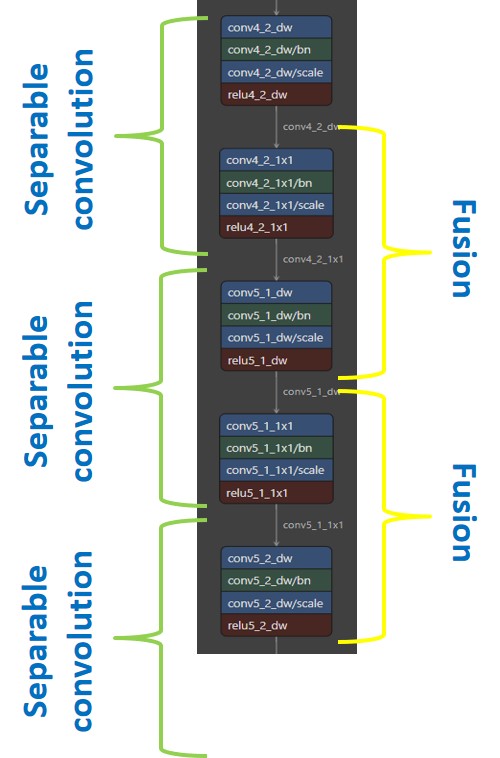oneDNN implements some basic capabilities of operation fusion using the post-ops attributes API. The operation fusion typically reduces the memory bandwidth pressure hence leading to higher performance.
Post-ops are operations that are appended after a primitive. They are implemented using the Primitive Attributes mechanism. If there are multiple post-ops, they are executed in the order they have been appended.
Currently the following post-ops are supported by the library:
Just like Primitive Attributes, the post-ops are represented by an opaque structure (dnnl_post_ops_t in C API and dnnl::post_ops in C++ API) which is copied once it is attached to the attributes using the C++ dnnl::primitive_attr::set_post_ops or C dnnl_primitive_attr_set_post_ops functions. The attributes then must be passed to a primitive descriptor creation function to take effect. Below is a simple skeleton for the C++ API:
The post-op object can be inspected using the dnnl::post_ops::kind() function that takes an index of the post-op (which must be less than the value returned by dnnl::post_ops::len()), and returns its kind.
The eltwise post-op enables fusing a primitive with an Eltwise primitive. This is probably one of the most popular kinds of fusion: an eltwise (typically an activation function) with preceding convolution or inner product.
The dnnl::primitive::kind of this post-op is dnnl::primitive::kind::eltwise.
API:
The parameters (C++ API for simplicity):
The alg, alpha, and beta parameters are the same as in Eltwise.
The eltwise post-op replaces:
\[ \dst[:] = \operatorname{Op}(...) \]
with
\[ \dst[:] = scale \cdot \operatorname{eltwise}( \operatorname{Op}(...) ) \]
The intermediate result of \(\operatorname{Op}(...)\) is not preserved. Hence, in most cases this kind of fusion cannot be used during training.
The \(scale\) factor is supported in INT8 inference only. For all other cases the scale must be 1.0.
The sum post-op accumulates the result of a primitive with the existing data. Prior to accumulating the result, the existing value would be multiplied by scale.
The kind of this post-op is dnnl::primitive::kind::sum.
This feature might improve performance for cases like residual learning blocks, where the result of a convolution is accumulated to the previously computed activations. The scale parameter can be used in [INT8](Primitive Attributes: Quantization) inference only when the result and previous activations have different magnitudes. For all other cases the scale must be 1.0.
The sum post-op replaces
\[ \dst[:] = \operatorname{Op}(...) \]
with
\[ \dst[:] = scale \cdot \dst[:] + \operatorname{Op}(...) \]
If the data type parameter is specified, the original destination tensor will be reinterpreted as a tensor with the provided data type. Because it is a reinterpretation, data_type and the destination data type must have the same size. As a result, the computation will be:
\[ \dst(:) = scale \cdot \operatorname{as_data_type}(\dst(:)) + \operatorname{Op}(...) \]
Appends a Depthwise convolution as a post-op. This post-op can only be fused with 1x1 convolution as generally seen in models (like MobileNet_v1) that use a stack of Separable convolutions: Depthwise convolution followed by 1x1 convolution. The stack of these Separable convolutions (like in MobileNet_v1) provide an opportunity to fuse 1x1-Convolution with bandwidth-limited Depthwise convolution.
The dnnl::primitive::kind of this post-op is dnnl::primitive::kind::convolution.
There are two variants of this post-op: dw_k3s1p1 and dw_k3_s2p1 for stride-1 and and stride-2 respectively.
API:
For better readability, below we assume a 2D convolution and use the following notations:
conv_1x1 Convolution with weights spatial=1 i.e., kh = kw = 1.
conv_dw Depthwise convolution with weights spatial=3 i.e., kh = kw = 3, g = oc = ic and pad_l = pad_r = {1, 1}.
The Depthwise post-op replaces
\[ dst[:] = Conv_{1x1}(...) \]
with
\[ dst[:] = Conv_{dw}(Conv_{1x1}(...)) \]
The final output dimensions of the after post-op is defined as
\[ dst_{conv_dw} = \{ n, oc_{1x1}, \operatorname{ceil}(oh_{conv_{1x1}}/stride), \operatorname{ceil}(ow_{conv_{1x1}}/stride) \} \]
where oh_conv_1x1, ow_conv_1x1 are height and width of conv_1x1 destination.

Supported data types
| conv 1x1 output data type | depthwise post-op output data type | depthwise post-op weights data type | dep |
|---|---|---|---|
| u8, s8 | u8, s8, s32, f32 | s8 | f32, s32 |
| f32 | f32 | f32 | f32 |
| bf16 | bf16, f32 | bf16 | f32, bf16 |
dst_1x1, wei_dw and dst_dw are assumed to be dnnl_format_tag_any.The binary post-op enables fusing a primitive with a Binary primitive.
The dnnl::primitive::kind of this post-op is dnnl::primitive::kind::binary.
API:
The parameters (C++ API for simplicity):
The alg and src1 parameters are the same as in Binary.
The binary post-op replaces:
\[ \dst[:] = \operatorname{Op}(...) \]
with
\[ \dst[:] = \operatorname{binary}(\operatorname{Op}(...), Source\_1[:]) \]
The intermediate result of \(\operatorname{Op}(...)\) is not preserved. Hence, in most cases this kind of fusion cannot be used during training.
Currently the following scenarios are supported:
dim[1] value of \(Source\_1\) coincides with a dim[1] value of \(\operatorname{Op}(...)\), i.e. {1, C, 1, 1} for 2D spatial \(\operatorname{Op}(...)\).Scenario when \(Source\_1\) represents a full tensor as \(\operatorname{Op}(...)\) is not supported yet.
Different post-ops can be chained together by appending one after another. Note that the order matters: the post-ops are executed in the order they have been appended.
Let's consider some examples.
This pattern is pretty common for the CNN topologies of the ResNet family.
This will lead to the following primitive behavior:
\[ \dst[:] = \operatorname{ReLU}(\dst[:] + \operatorname{conv}(\src[:], \weights[:]) \]
This is a hypothetical example that illustrates the sequence of operations applied. We also set all the scales to values other than 1.0 and use dnnl::primitive_attr::set_output_scales which will be covered in Primitive Attributes: Quantization.
This will lead to the following primitive behavior (for better readability the tensors are designated by their names only; i.e., [:] is omitted):
\[ \dst = s_{linear} \cdot ( \alpha \cdot ( s_{sum} \cdot \dst + s_{tanh} \cdot \tanh ( s_{conv} \cdot \operatorname{conv}(\src, \weights) ) ) + \beta ) \]
An example of fusing depthwise convolution with 1x1 convolution in MobileNet.
This will lead to the following primitive behaviour:
\[ dst = ReLU_{depthwise} ( scales_{depthwise} \cdot ( conv_{depthwise} ( ReLU_{1x1} ( scales_{conv_{1x1}} \cdot ( conv_{1x1}() ) ) ) ) ) \]
An example of fusing convolution with binary post-op with per channel addition.